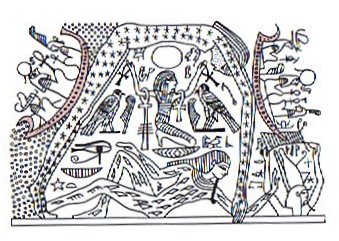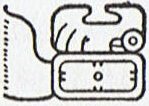1. Working with the planets has turned into a questionable method. Once again - I have tried to apply the same method as the Old Babylonians used when they defined the names of the days of the week by counting 24 hours ahead using 1 planet per hour. 24 / 7 = 21 + 3 meant each new day had to begin with not the next planet in the line but with the planet in position +3 compared to the one who just had finished his rule. With 8 instead of 24 the next ruler will be the planet in position +1 which seems more natural:
5 (rima) should be assigned to the great flame in the sky, viz. Spring Sun. It can be accomplished by counting from puo in Gb8-30:
Saturn must then be in Ga1-3 and we can imagine the bent henua as a picture of the lower half-shell which became earth. Old-Spider placed Sun beside the lower half-shell, in front of it of course. This is not so far fetched as it may seem, because I have a glyph type named pure (cowrie) consisting of a pair of opposedly bent henua signs:
Tagata (with short neck) in Ga1-2 is rising his arms in a gesture which evidently, according to Egyptian ideas, indicates the position to receive a new 'world' (or 'half-shell' formed like a canoe):
Maybe already Ga1-1 describes it, how a descending old world (henua at left) rises again at right, with an open cup between the new henua and its later transformation into a waning crescent. The 2 vertically arranged 'eyes', to the left of tagata, are hanging from a string (it is night), and they are positioned between 2 crescents (at right in Ga1-1 and at left in Ga1-2). They are generated from a waxing crescent. As I understand it the season of 'sea' is in the past. It began with Mercury (the liquid planet) who like Moon has 2 faces. But now this season is 'hilled up' and its 'eyes' have been fished up by the waxing crescent - which in this situation does not need to represent Waxing Moon, it is rather an expression of how growth is based on the previous generation. Maybe the first glyphs of the text correspond to the 3 islets outside the southwestern corner of Easter Island. This is where the living spirit for the new year is received in form manu tara eggs (also a kind of 'eyes'). If so, then we ought to have earth (Saturn) as the first glyph of the mainland:
The earth is a square (4), and to get Saturn as number 4 we must add Gb8-30 at the beginning. By force of my suggested equation 1 planet = 1 glyph we can then split up the first 8-group into 2 subgroups, with Mercury in Ga1-7 (as in 17) at the beginning of the 2nd such subgroup. Fishes indicate 'sea' and in Ga1-10 there is a half-shell which is lesser than that in Ga1-3 and it should be the 'land of Moon' we can imagine. In other words, I suggest that the beginning of the text is a short preview of the whole cycle of the text. Tagata rere (the left figures in Ga1-7 and Ga1-9) have the peculiar 'leg' of moe at the end of Kuukuu:
The back side of the tail in the pair of tagata rere is cut off abruptly, perhaps illustrating that 'land' is in the past. And the form of the Mayan grasping hand in the west (Chikin) can be imagined:
The 'wing' at left in the Mayan glyph seems to have 13 'feathers', and it could illustrate how the gap between sky and earth gradually is closing. Sun is moving down. Why should I use groups with 8 glyphs? It seems more reasonable to let the 2nd cycle of the year begin with Mercury and end with tagata gagana in Ga1-11:
Counting from Saturn in Ga1-3 the number of glyphs are (1 + 3) (land) + 5 (sea) = 9 which should symbolize the end of Sun. Therefore the death skull and no 2nd glyph (although Ga1-11 is in the 2nd part of the full cycle). Counting from Gb8-30 the number of glyphs are 3 (islets, 'eyes') + 4 (earth) + 5 (sea) = 12 as in the number of months in a cycle of Sun. 3² + 4² = 5². Hanau in Ga1-12 and Ga1-14 has Mars (ariki in Ga1-13) 'inside' (between them), in a way which resembles how Te is inside Hatinga Te Kohe. Sun is no longer visible:
Earlier I have guessed:
but I think my new interpretation is more in line with all the rest. It is Sun (red) who dies at Ga1-11 and it is Mars who is embedded between the pair of hanau glyphs to be born again later, not Moon. I.e., the counting should begin with Gb8-30. Comparing with the geography of Easter Island we can try to put in parallel the first 4 glyphs with the kuhane stations around Rano Kau:
Then comes 3 stations 'out in the light'
The 8th station, Hua Reva, must then be put in parallel with 4 glyphs in order to fit with the following Akahanga:
And 10 Hatinga Te Kohe should begin a new series:
My attempt at using groups of 8 glyphs = 8 planets evidently is a failure, at least at the beginning of line a1. |
|||||||||||||||||||||||||||||||||||||||||||||||||||||||||||||||||||||||||||||||||||||||||||||||||||||||||||||||||||||||||||||||||||||||||||||||||||||||||||||||||||||||||||||||||||||||||||||||||||||||||||||||||||||||||||||||||||||||||||||||||||||||||||||











